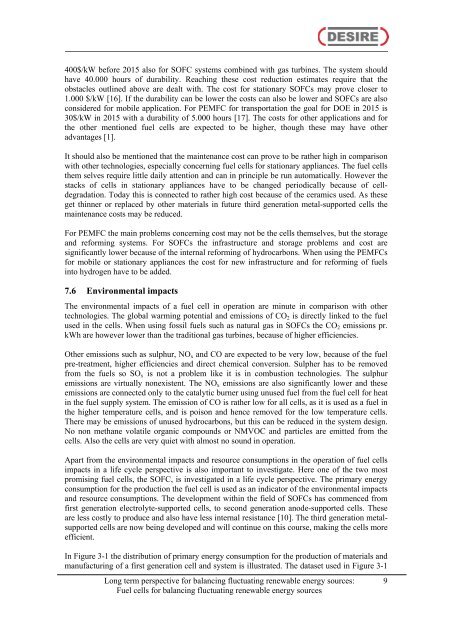Fuel cells and electrolysers in future energy systems - VBN
Fuel cells and electrolysers in future energy systems - VBN
Fuel cells and electrolysers in future energy systems - VBN
Create successful ePaper yourself
Turn your PDF publications into a flip-book with our unique Google optimized e-Paper software.
400$/kW before 2015 also for SOFC <strong>systems</strong> comb<strong>in</strong>ed with gas turb<strong>in</strong>es. The system should<br />
have 40.000 hours of durability. Reach<strong>in</strong>g these cost reduction estimates require that the<br />
obstacles outl<strong>in</strong>ed above are dealt with. The cost for stationary SOFCs may prove closer to<br />
1.000 $/kW [16]. If the durability can be lower the costs can also be lower <strong>and</strong> SOFCs are also<br />
considered for mobile application. For PEMFC for transportation the goal for DOE <strong>in</strong> 2015 is<br />
30$/kW <strong>in</strong> 2015 with a durability of 5.000 hours [17]. The costs for other applications <strong>and</strong> for<br />
the other mentioned fuel <strong>cells</strong> are expected to be higher, though these may have other<br />
advantages [1].<br />
It should also be mentioned that the ma<strong>in</strong>tenance cost can prove to be rather high <strong>in</strong> comparison<br />
with other technologies, especially concern<strong>in</strong>g fuel <strong>cells</strong> for stationary appliances. The fuel <strong>cells</strong><br />
them selves require little daily attention <strong>and</strong> can <strong>in</strong> pr<strong>in</strong>ciple be run automatically. However the<br />
stacks of <strong>cells</strong> <strong>in</strong> stationary appliances have to be changed periodically because of celldegradation.<br />
Today this is connected to rather high cost because of the ceramics used. As these<br />
get th<strong>in</strong>ner or replaced by other materials <strong>in</strong> <strong>future</strong> third generation metal-supported <strong>cells</strong> the<br />
ma<strong>in</strong>tenance costs may be reduced.<br />
For PEMFC the ma<strong>in</strong> problems concern<strong>in</strong>g cost may not be the <strong>cells</strong> themselves, but the storage<br />
<strong>and</strong> reform<strong>in</strong>g <strong>systems</strong>. For SOFCs the <strong>in</strong>frastructure <strong>and</strong> storage problems <strong>and</strong> cost are<br />
significantly lower because of the <strong>in</strong>ternal reform<strong>in</strong>g of hydrocarbons. When us<strong>in</strong>g the PEMFCs<br />
for mobile or stationary appliances the cost for new <strong>in</strong>frastructure <strong>and</strong> for reform<strong>in</strong>g of fuels<br />
<strong>in</strong>to hydrogen have to be added.<br />
7.6 Environmental impacts<br />
The environmental impacts of a fuel cell <strong>in</strong> operation are m<strong>in</strong>ute <strong>in</strong> comparison with other<br />
technologies. The global warm<strong>in</strong>g potential <strong>and</strong> emissions of CO2 is directly l<strong>in</strong>ked to the fuel<br />
used <strong>in</strong> the <strong>cells</strong>. When us<strong>in</strong>g fossil fuels such as natural gas <strong>in</strong> SOFCs the CO2 emissions pr.<br />
kWh are however lower than the traditional gas turb<strong>in</strong>es, because of higher efficiencies.<br />
Other emissions such as sulphur, NOx <strong>and</strong> CO are expected to be very low, because of the fuel<br />
pre-treatment, higher efficiencies <strong>and</strong> direct chemical conversion. Sulpher has to be removed<br />
from the fuels so SOx is not a problem like it is <strong>in</strong> combustion technologies. The sulphur<br />
emissions are virtually nonexistent. The NOx emissions are also significantly lower <strong>and</strong> these<br />
emissions are connected only to the catalytic burner us<strong>in</strong>g unused fuel from the fuel cell for heat<br />
<strong>in</strong> the fuel supply system. The emission of CO is rather low for all <strong>cells</strong>, as it is used as a fuel <strong>in</strong><br />
the higher temperature <strong>cells</strong>, <strong>and</strong> is poison <strong>and</strong> hence removed for the low temperature <strong>cells</strong>.<br />
There may be emissions of unused hydrocarbons, but this can be reduced <strong>in</strong> the system design.<br />
No non methane volatile organic compounds or NMVOC <strong>and</strong> particles are emitted from the<br />
<strong>cells</strong>. Also the <strong>cells</strong> are very quiet with almost no sound <strong>in</strong> operation.<br />
Apart from the environmental impacts <strong>and</strong> resource consumptions <strong>in</strong> the operation of fuel <strong>cells</strong><br />
impacts <strong>in</strong> a life cycle perspective is also important to <strong>in</strong>vestigate. Here one of the two most<br />
promis<strong>in</strong>g fuel <strong>cells</strong>, the SOFC, is <strong>in</strong>vestigated <strong>in</strong> a life cycle perspective. The primary <strong>energy</strong><br />
consumption for the production the fuel cell is used as an <strong>in</strong>dicator of the environmental impacts<br />
<strong>and</strong> resource consumptions. The development with<strong>in</strong> the field of SOFCs has commenced from<br />
first generation electrolyte-supported <strong>cells</strong>, to second generation anode-supported <strong>cells</strong>. These<br />
are less costly to produce <strong>and</strong> also have less <strong>in</strong>ternal resistance [10]. The third generation metalsupported<br />
<strong>cells</strong> are now be<strong>in</strong>g developed <strong>and</strong> will cont<strong>in</strong>ue on this course, mak<strong>in</strong>g the <strong>cells</strong> more<br />
efficient.<br />
In Figure 3-1 the distribution of primary <strong>energy</strong> consumption for the production of materials <strong>and</strong><br />
manufactur<strong>in</strong>g of a first generation cell <strong>and</strong> system is illustrated. The dataset used <strong>in</strong> Figure 3-1<br />
Long term perspective for balanc<strong>in</strong>g fluctuat<strong>in</strong>g renewable <strong>energy</strong> sources:<br />
<strong>Fuel</strong> <strong>cells</strong> for balanc<strong>in</strong>g fluctuat<strong>in</strong>g renewable <strong>energy</strong> sources<br />
9

















